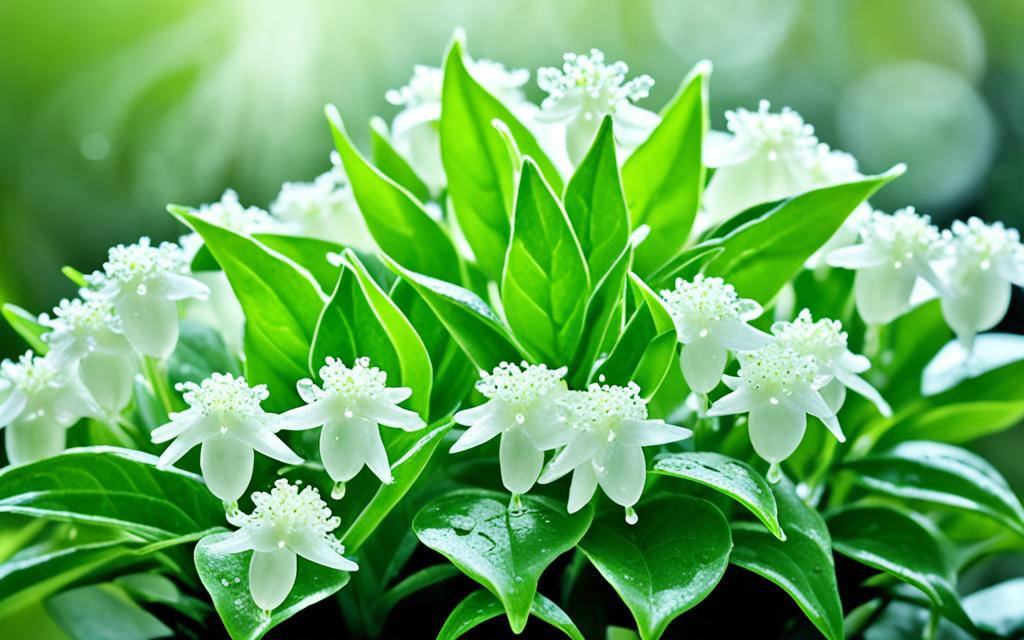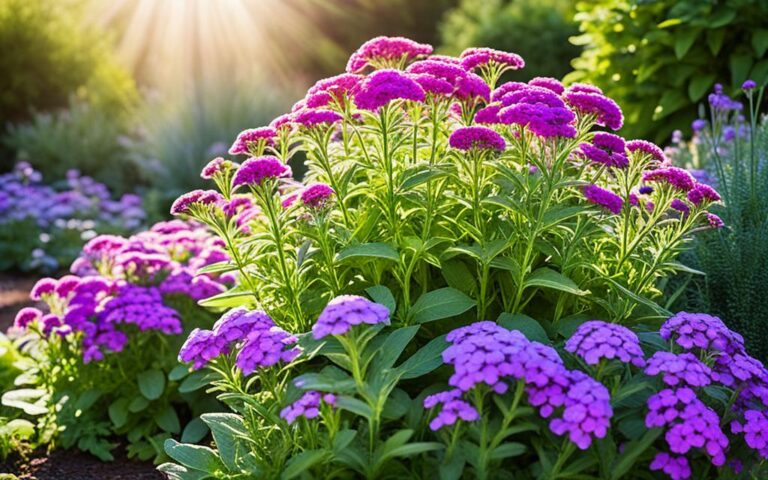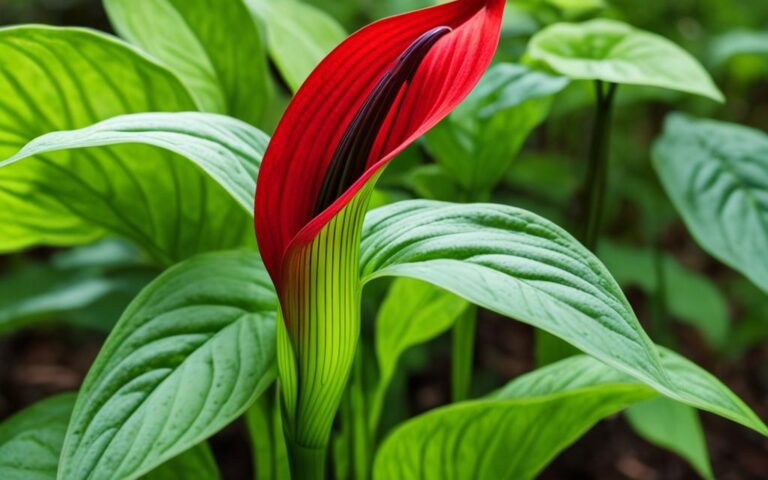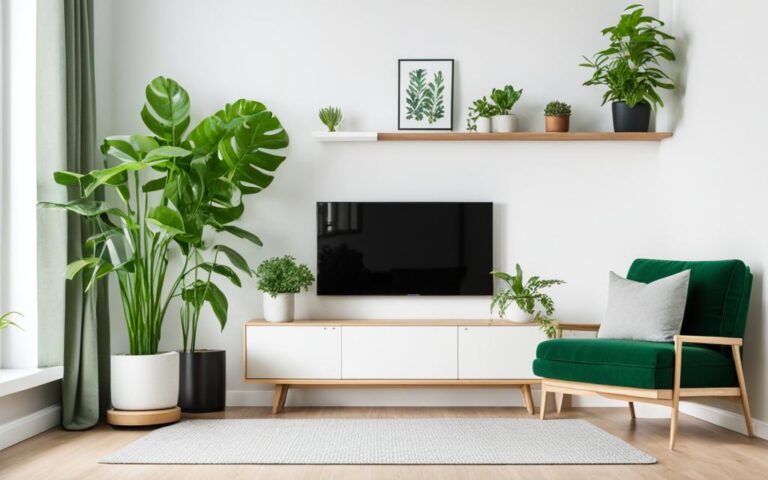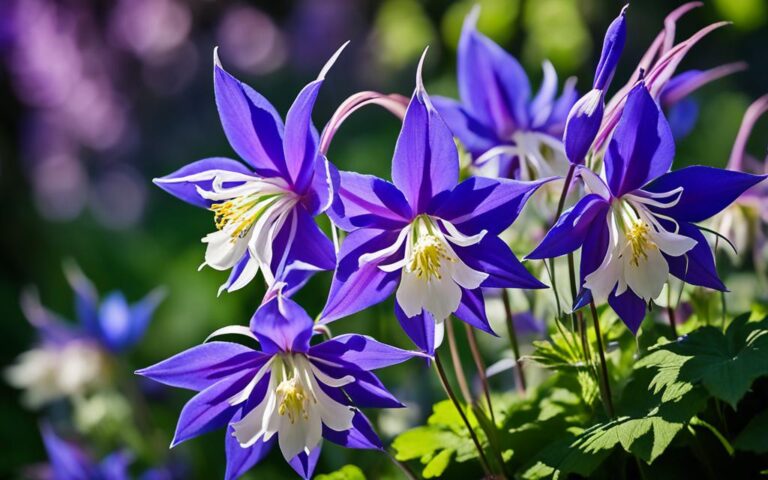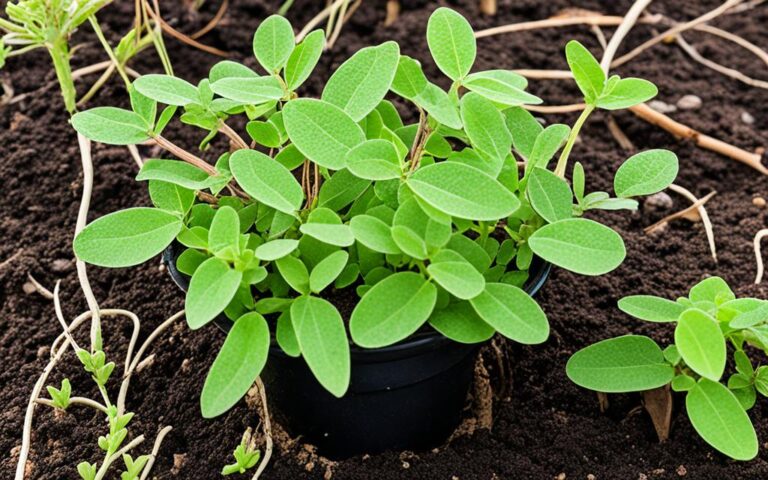Angel Plant: Care Tips for Your Heavenly Houseplant
Did you know the Exotic Angel® brand has over 400 plant types? These angel plants, also known as angel’s trumpet or brugmansia, are part of the Solanaceae family. They are loved for their big, trumpet-shaped flowers in colors like white, pink, yellow, and red. These plants are exotic and fragrant, perfect for gardens and homes. But, some types can be poisonous if eaten, so it’s important to care for them properly.
Key Takeaways
- Angel plants, also known as angel’s trumpet or brugmansia, are a group of flowering plants in the Solanaceae family.
- They are known for their large, trumpet-shaped blooms in a range of colors, including white, pink, yellow, and red.
- Some angel plant varieties can be poisonous if ingested, so proper care and handling is essential.
- The Exotic Angel® brand offers over 400 different angel plant varieties, showcasing the diversity within this category of houseplants.
- Learning how to properly care for an angel plant, including providing the right lighting, temperature, humidity, and watering, is key to keeping it healthy and thriving.
What is an Angel Plant?
Angel plants, also known as Exotic Angel® plants, are a variety of houseplants from Costa Farms. They offer over 400 varieties. You can find popular houseplants like ficus, ferns, pothos, laceleaf, dumb cane, dragon plant, and purple passion plant.
Exotic Angel® Brand
The Exotic Angel® brand is not just one plant. It’s a quality standard from Costa Farms, famous for their hermann engelmann greenhouses. These plants grow well because of careful growing and health focus.
Common Varieties and Characteristics
The Exotic Angel® collection has many houseplants, each with its own look and care needs. You’ll find everything from the ficus tree’s wide leaves to the fine ferns and the climbing pothos. For those wanting something different, there are laceleaf, dumb cane, dragon plant, and purple passion plant too.
Whether you’re new to plants or have been growing them for years, the Exotic Angel® brand has many high-quality options. Costa Farms makes sure each Exotic Angel® plant is a great choice for your home.
Anatomy and Features of Angel Plants
Angel plants are part of the Begonia genus and are known for their unique looks. They include species like B. coccinea, B. corallina, and B. dietrichiana. These plants stand out with their strong, upright cane-like stems and leaves that are wing-shaped. The leaves often have light dots or streaks and sometimes show red undersides, making them more attractive.
Leaves, Stems, and Flowers
Angel plants are famous for their asymmetrical, wing-shaped leaves. Some, like the polka dot plant (B. maculata), have big polka dot patterns on their leaves. They also produce clusters of pink, white, or red flowers along their stems, which looks amazing.
Unique Characteristics
Angel plants are special because of their unique growth and looks. Their cane-like stems are strong and upright. The asymmetrical, wing-shaped leaves and vibrant floral displays make them stand out. These features make angel plants a beautiful choice for any garden, inside or outside.
Ideal Growing Conditions
To make sure your angel plant does well, you need to give it the right conditions. These lovely houseplants love bright, indirect sunlight. They do best in an east-facing window or a spot that gets morning sun. But, keep them away from direct sunlight to prevent damage.
Light Requirements
Angel plants need a lot of light to stay healthy and look good. Try to keep your plant within 3 feet of a south-facing window for the best growth. If it doesn’t get enough light, it might lose leaves and look stretched out.
Temperature and Humidity
These tropical plants like warm temperatures between 65-85°F and humidity around 40-50%. Don’t let them get too cold or have sudden changes in temperature. This can stress them out and cause problems.
Soil and Water Needs
Angel plants do well in soil that drains well and has lots of nutrients. Make sure the soil dries out a bit between waterings to prevent root rot. Water your plant when the top few inches of soil feel dry, giving it about 0.5 cups of water every 9 days. Moving the plant into a new pot when it gets too big or once a year will keep it healthy.
By giving your angel plant the right conditions, you can help it thrive. Enjoy its beautiful leaves and flowers for many years.
Propagating Angel Plants
Propagating angel plants lets you grow your indoor garden and share with loved ones. The Angel Wing Begonia is a popular choice for this. You can easily grow new plants using cuttings or division.
To take cuttings, pick a healthy angel plant. You can do this any time of year. Cut stems that are 4-6 inches long, making sure there’s at least one node. Roots will start growing in water or soil mix within weeks, and you’ll see fast growth soon after.
For division, take the plant out of its pot and separate the roots. This method helps older plants and makes new ones.
Growing angel plants from seed is harder because the seeds are small and may not be like the parent plant. But, cutting or dividing is easier and more reliable for most gardeners.
| Propagation Method | Success Rate | Time to Root |
|---|---|---|
| Stem Cuttings | ~40% | 4-8 weeks |
| Division | ~60% | 2-4 weeks |
| Seeds | ~30% | 6-12 weeks |
Success in growing angel plants comes from good care and patience. With the right steps, you can grow new angel plant specimens from your current plants.
Care and Maintenance Essentials
Keeping angel plants healthy is key. Regular pruning and training help shape the plant and encourage more growth. It’s also important to remove dead or diseased parts.
Pruning and Training
Pruning your angel plant helps keep it looking great and full. Cut off dead, damaged, or long leaves, but don’t take off more than one-third at once. Use sharp shears and make cuts just above a leaf node. To shape the stems, tie them to a support or use clips.
Pest and Disease Management
Watch out for pests like mealybugs, spider mites, and aphids. Check your plants often and deal with infestations quickly. Use a damp cloth or mild insecticidal soap to get rid of pests. Also, keep an eye out for fungal diseases. Good air flow and less moisture can help prevent these.
Fertilizing for Optimal Growth
Feed your angel plant with a balanced liquid fertilizer every 2-4 weeks when it’s growing. Choose a fertilizer made for foliage plants or houseplants. Always follow the directions on the label. But don’t overdo it, as too much fertilizer can harm your plant.
“Proper care and maintenance are the keys to keeping your angel plant thriving and looking its best.”
Angel Plant Varieties to Explore
The term “angel plant” covers many different types, each with its own special features. Gardeners can easily find the right one for their space and taste by looking at all the options.
The angel wing begonia is a favorite for its beautiful, wing-shaped leaves. These leaves bring elegance to any indoor spot. The nerve plant also catches the eye with its unique, mosaic-patterned leaves. It can brighten up any room.
- The tall, upright dieffenbachia stands out in any collection.
- The small, slow-growing peperomia is ideal for small spaces.
- The croton has vibrant, multicolored leaves that grab attention.
- The hoya is easy to care for and produces lovely, fragrant flowers.
- The zebra plant has striking dark green and white striped leaves, making it stand out.
- The purple pleasure plant brings a bold purple color to any room.
Looking into the world of angel plants helps gardeners find the perfect match for their needs and tastes. This creates a beautiful and rewarding indoor space.
Common Problems and Solutions
Angel plants can face issues if their care needs aren’t met. Overwatering is a common problem, causing soft stems, dark spots, and yellow leaves. Check for root rot and repot in fresh soil if needed.
Underwatering makes leaves dry and crispy. Lack of light makes leaves fade. Pests like mealybugs, spider mites, and aphids can also infest them. Use insecticides or natural remedies to treat them. Fixing these issues quickly keeps angel plants healthy.
Overwatering Signs and Remedies
- Symptoms include soft, mushy stems, dark spots, and yellowing leaves
- Check for root rot and repot in fresh, well-draining soil if needed
- Angel plants prefer lightly moist soil and are more forgiving of under-watering
Underwatering and Light Issues
- Dry, crispy leaves indicate underwatering
- Insufficient light can lead to washed-out, faded colors
- Angel plants prefer bright, indirect light but can tolerate lower light levels
Pest Infestations
| Pest | Symptoms | Treatment |
|---|---|---|
| Mealybugs | White, cottony masses on plant | Rubbing alcohol, insecticidal soap |
| Spider Mites | Fine webbing, stippling on leaves | Insecticidal soap, neem oil |
| Aphids | Sticky, shiny leaves, distorted growth | Soapy water, insecticidal sprays |
Keeping tools and pots clean helps prevent pests and diseases in angel plants. Quarantining new plants also helps avoid pests in your collection.
Interesting Facts About Angel Plants
Angel plants, also known as angel’s trumpet or brugmansia, have a rich history. They belong to the Solanaceae family, which includes plants like tomatoes and deadly nightshade. These plants have been loved for their big, trumpet-shaped flowers and strong scent for a long time.
All parts of the angel plant are poisonous if eaten. This fact has made them useful in traditional medicine and rituals in some places. The name Brugmansia comes from Sebald Justin Brugmans, a Dutch botanist who studied the plant’s dangers.
The angel plant’s relative, Datura, is known for its hallucinogenic effects. It has been used in spiritual practices by many indigenous cultures. Both Brugmansia and Datura are very toxic and need to be handled carefully.
Even though they are toxic, angel plants are still popular as houseplants. They are known for their beautiful look and are easy to take care of. Costa Farms offers over 200 types of these plants, making them a great choice for indoor gardening.
“Angel plants have a long and fascinating history, from their use in traditional medicine to their designation as a controlled substance in some regions. While their toxicity should not be underestimated, their beauty and easy-care nature continue to make them a popular choice for indoor gardeners.”
Benefits of Growing Angel Plants
Apart from their beautiful look, angel plants bring many benefits indoors and outdoors. They belong to the Solanaceae family and are great at cleaning the air by removing toxins. This makes your home or office healthier. Their sweet smell can also make you feel calm and happy.
Angel plants are perfect for adding beauty to gardens, patios, or as indoor plants. They are easy to take care of, making them great for both new and experienced plant lovers. Studies show that having plants at work can make people more productive and healthier.
| Benefit | Description |
|---|---|
| Air Purification | Angel plants are part of the Solanaceae family. They are great at removing toxins from the air, making your space cleaner. |
| Fragrance | The sweet smell of angel plants can make your space feel calm and relaxing. It can also lift your mood and improve your well-being. |
| Ornamental Value | Angel plants have beautiful leaves and flowers. They can be the main attraction in gardens, on patios, or as indoor plants. They add a unique touch to any area. |
| Low Maintenance | Angel plants are easy to care for. This makes them perfect for both beginners and seasoned plant lovers. |
Angel plants can make your living or work space more beautiful and healthy. They offer many benefits to explore and enjoy.
Cultivation and History
The angel-wing begonias come from the lush areas of Brazil. Charles Plumier, a Franciscan monk and botanist, first described the Begonia genus in the early 1700s. Over the next 150 years, European gardeners found over 200 begonia species. Each one had its own special look and feel.
Today’s popular angel-wing begonias come from careful breeding. The ‘Lucerne’ variety was introduced in 1892. The ‘Irene Nuss’ Superba hybrid came later, in the 1920s, thanks to Eva Kenworthy Gray in California. These hybrids are loved for their colors and shapes, making them favorites for both indoor and outdoor gardens.
- Angel-wing begonias are native to parts of Brazil.
- The Begonia genus was first described by Charles Plumier, a Franciscan monk and botanist, in the early 1700s.
- Over the past century and a half, gardeners have found over 200 Begonia species.
- Popular angel-wing hybrids include the ‘Lucerne’ cultivar (1892) and the ‘Irene Nuss’ Superba (1920s).
- The easy propagation and diverse colors and forms have made angel-wing begonias favorites among gardeners.
“The ease of propagation and wide range of colors and forms have made angel-wing begonias enduring favorites among indoor and outdoor gardeners.”
Angel Wing Begonias vs. Other Begonia Types
The term “angel-wing begonia” actually points to specific types within the Begonia family. These include B. coccinea, B. corallina, and B. dietrichiana. They stand out with their strong stems and leaves shaped like wings. It’s crucial to know how they differ from other begonias, like the hardy begonias (B. grandis) or the rex begonias (B. x rex cultorum). Each type has its own way of growing and needs different care.
Angel Wing Begonias bloom from May or June until the year ends, showing off green leaves with pink flowers. Dragon Wing Begonias have lighter pink flowers but don’t bloom as much. Both types love filtered sun or partial shade.
| Characteristic | Angel Wing Begonia | Dragon Wing Begonia | Hardy Begonia | Rex Begonia |
|---|---|---|---|---|
| Leaf Shape | Asymmetrical, wing-shaped | Ruffly, deep green with polka dots and red undersides | Rounded, paisley-shaped | Colorful, patterned |
| Growth Habit | Upright, cane-like stems | Stems 2-4 feet long | Varied | Varied |
| Bloom Characteristics | Profuse, pink flowers | Lighter pinky-white flowers, less abundant | Varied | Varied |
| Leaf Size | 5-6 inches long | 2-5 inches long | Varied | Varied, can reach 6-7 feet |
Begonias are easy to grow and can be spread by cutting and planting. They handle heat, humidity, and sunlight well, perfect for tropical areas. With over 1,600 types, begonias show a wide range of leaf shapes, sizes, and growth patterns.
Propagation Methods for Angel Plants
Angel plants are easy to spread out or share with friends because of their beautiful leaves and flowers. You can grow them using stem cuttings or seeds.
From Cuttings
Taking stem cuttings is a popular way to grow more angel plants. You can do this all year, and the cuttings will grow roots fast in water or soil. Exotic Angel® plants use more cuttings to make bigger, fuller plants.
For cuttings, pick 3-4 inch pieces with a few leaves. Let them dry out for 1-3 days before putting them in soil. You can use rooting hormone or natural stuff like honey or cinnamon to help them grow roots faster. Keep the soil a bit damp, and in 2-4 weeks, roots will start to show.
From Seeds
Growing angel plants from seeds is a bit harder. Seeds are tiny and need special conditions to grow, and the new plants might not look like the parent. Exotic Angel® plants are hybrids made for indoor plants, so seed results can vary.
For seed success, plant them in spring or early summer when the plant is busy growing. Keep the temperature between 20°C to 25°C (68°F to 77°F) and give them bright, indirect light for six hours a day. Germination can take weeks, so be patient.
Whether you pick cuttings or seeds, the main thing is to give your angel plants the right care. With some effort, you can grow more of these lovely plants and share them with others.
Conclusion
Angel plants are perfect for adding beauty to any garden or indoor area. They look striking and exotic. With the right angel plant care, growing tips, and propagation methods, they will flourish and give beautiful flowers and leaves.
These plants are great for both indoor and outdoor settings. They clean the air and add beauty to any space. By following the advice in this guide, you can make the most of these heavenly plants.
Learn how to give them the best light, temperature, and humidity. This guide covers everything you need to know for healthy, vibrant angel plants. They are beautiful and useful, making any space more magical.
Let these amazing plants bring beauty and peace to your home or garden. With the right care and knowledge, you can create a beautiful angel plant area. It will be a place of beauty and inspiration for years.
